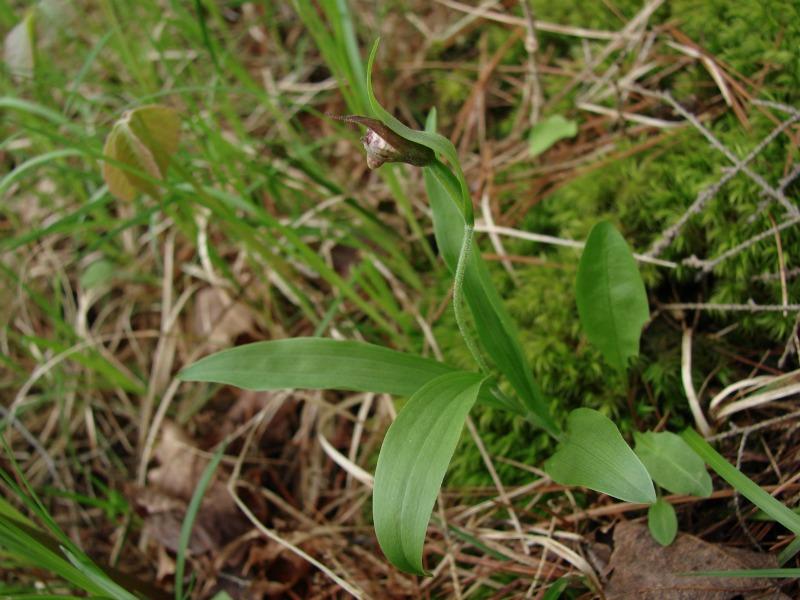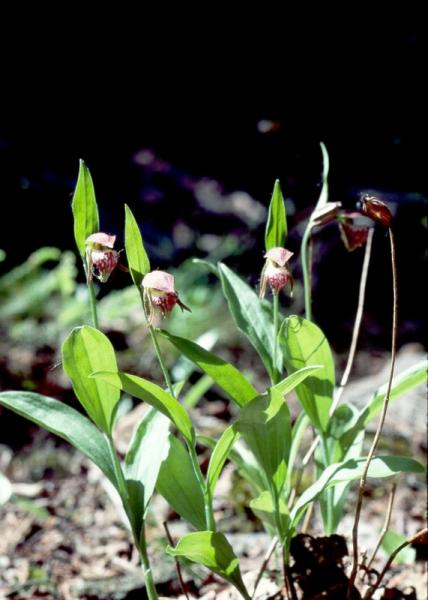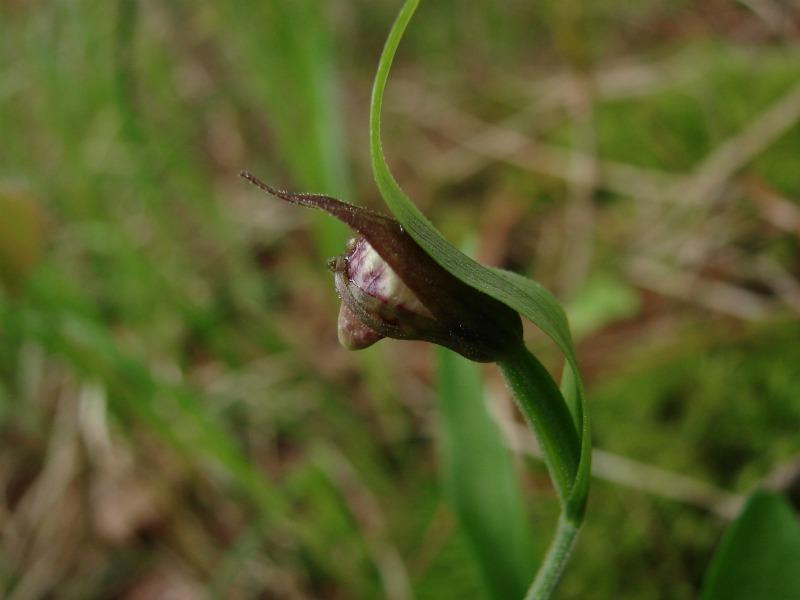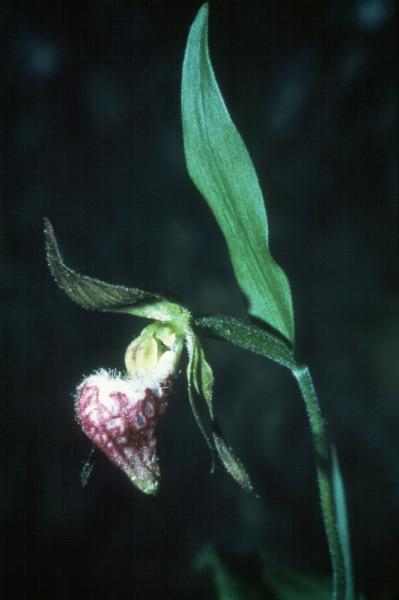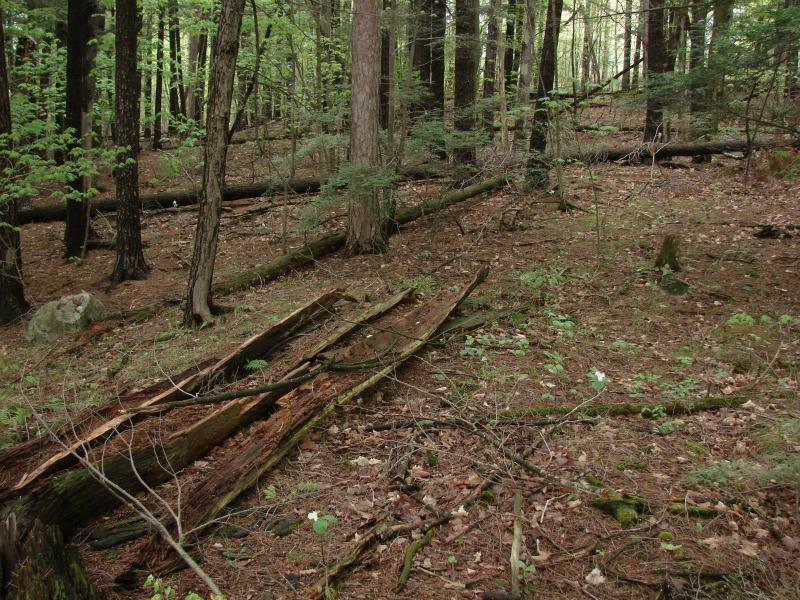Ram's Head Lady's Slipper
Cypripedium arietinum Ait. f.
- Class
- Monocotyledoneae (Monocots)
- Family
- Orchidaceae (Orchid Family)
- State Protection
- Threatened
Listed as Threatened by New York State: likely to become Endangered in the foreseeable future. For animals, taking, importation, transportation, or possession is prohibited, except under license or permit. For plants, removal or damage without the consent of the landowner is prohibited.
- Federal Protection
- Not Listed
- State Conservation Status Rank
- S2
Imperiled in New York - Very vulnerable to disappearing from New York due to rarity or other factors; typically 6 to 20 populations or locations in New York, very few individuals, very restricted range, few remaining acres (or miles of stream), and/or steep declines.
- Global Conservation Status Rank
- G3
Vulnerable globally - At moderate risk of extinction due to rarity or other factors; typically 80 or fewer populations or locations in the world, few individuals, restricted range, few remaining acres (or miles of stream), and/or recent and widespread declines.
Summary
Did you know?
Like other Cypripedium species, Ram's head Ladyslippers have what's called a "deceptive" pollination system. The flowers' showy petals and odor attracts bees, but produces no reward of nectar. Thus the species must rely on "naïve" bees to transfer pollen between flowers before learning to avoid such fruitless efforts.
State Ranking Justification
There are 13 verified occurrences and 26 historical occurrences. Several occurrences first known from the 1980's have not been seen in subsequent visits. Of 5 historical locations visited, none have been rediscovered. The reasons for this orchid's decline, in spite of its fairly broad habitat tolerances, are not well understood.
Short-term Trends
Several occurrences known from the 1980's have not been seen in subsequent visits, and others have declined. Only 1 population is known to still have more than 100 plants.
Long-term Trends
From 1850 to 1950 there were a minimum of 26 known populations; today just half that number are considered extant. Additional surveys are needed, as only 5 known historical locations for this species have been checked.
Conservation and Management
Threats
Both natural succession and human disturbance are likely implicated in the extirpation or reduction of this orchid at historical sites, and so are threats to existing ones. Deer herbivory, human collection, and even severe storm events may also threaten small populations.
Conservation Strategies and Management Practices
The largest population of this species occurs at a relatively pristine area of open woodland. This species often occurs in open habitats, so careful management to maintain openings may be appropriate if succession threatens other populations.
Research Needs
Research is needed to determine the habitat requirements, reasons for decline, and appropriate management of this orchid.
Habitat
Habitat
Across its range Ram's head Ladyslipper has occupied a wide range of habitats with conditions ranging from inundated to dry-mesic and acidic to calcareous. Cold soils and moderately open conditions are characteristic. In the Great Lakes Region many of the largest populations have occupied successional dune forests and dune-coniferous woods edges, often associated with Thuja occidentalis, Pinus bansksiana, and/or Abies balsamea, though it is certainly not limited to such habitats (Voss 1975, WI NHP 1990, Shultz 1988, MI NFI 1990). In the northeastern states, including New York, it occupies second-growth mixed hardwood -conifer forests, limestone barrens and rocky outcrops, and forested peatlands (NYNHP 2007). In New York most current sites are in white-cedar swamps, though colonies are larger in upland habitats (Mitchell and Sheviak 1981, NYNHP 2007).
Associated Ecological Communities
- Alvar shrubland*
(guide)
A shrub-dominated community that has over 25% cover of tall, short, and dwarf shrubs. There are often deep crevices or grikes in the limestone pavement; trees and shrubs are often rooted in the grikes.
- Alvar woodland*
(guide)
A subset of the limestone woodland community restricted to the alvar region in Jefferson County, New York.
- Calcareous cliff community*
(guide)
A community that occurs on vertical exposures of resistant, calcareous bedrock (such as limestone or dolomite) or consolidated material; these cliffs often include ledges and small areas of talus.
- Calcareous red cedar barrens*
(guide)
A small-patch calcareous rocky summit community occurring on dry, south-facing to southwest-facing slopes and low summits. These sites are characterized by stunted, sparse woodlands with small grassland openings.
- Calcareous shoreline outcrop*
(guide)
A community that occurs along the shores of lakes and streams on outcrops of calcareous rocks such as limestone and dolomite. The vegetation is sparse; most plants are rooted in rock crevices.
- Calcareous talus slope woodland*
(guide)
An open or closed canopy community that occurs on talus slopes composed of calcareous bedrock such as limestone or dolomite. The soils are usually moist and loamy; there may be numerous rock outcrops.
- Great Lakes dunes*
(guide)
A community dominated by grasses and shrubs that occurs on active and stabilized sand dunes along the shores of the Great Lakes. Unstable dunes are sparsely vegetated, whereas the vegetation of stable dunes is more dense, and can eventually become forested.
- Hemlock-hardwood swamp*
(guide)
A swamp that occurs on mineral soils and deep muck in depressions which receive groundwater discharge. These swamps usually have a fairly closed canopy (70 to 90% cover), sparse shrub layer, and low species diversity. The tree canopy is typically dominated by eastern hemlock and co-dominated by yellow birch and red maple.
- Hemlock-northern hardwood forest*
(guide)
A mixed forest that typically occurs on middle to lower slopes of ravines, on cool, mid-elevation slopes, and on moist, well-drained sites at the margins of swamps. Eastern hemlock is present and is often the most abundant tree in the forest.
- Limestone woodland
(guide)
A woodland that occurs on shallow soils over limestone bedrock in non-alvar settings, and usually includes numerous rock outcrops. There are usually several codominant trees, although one species may become dominant in any one stand.
- Northern white cedar rocky summit*
(guide)
A community that occurs on cool, dry, rocky ridgetops and summits where the bedrock is calcareous (such as limestone or dolomite), and the soils are more or less calcareous. The vegetation may be sparse or patchy, with numerous rock outcrops. The species have predominantly boreal distributions.
- Northern white cedar swamp
(guide)
A swamp that occurs on organic soils in cool, poorly drained depressions in central and northern New York, and along lakes and streams in the northern half of the state. These swamps are often spring-fed with continually saturated soils. Soils are often rich in calcium. The characteristic tree is northern white cedar, which makes up more than 30% of the canopy cover.
- Spruce-northern hardwood forest*
(guide)
A mixed forest that occurs on lower mountain slopes and upper margins of flats on glacial till. This is a broadly defined community with several variants; it is one of the most common forest types in the Adirondacks. Codominant trees are red spruce, sugar maple, American beech, yellow birch, and red maple, with scattered balsam fir.
- Successional northern hardwoods*
A hardwood or mixed forest that occurs on sites that have been cleared or otherwise disturbed. Canopy trees are usually relatively young in age (25-50 years old) and signs of earlier forest disturbance are often evident. Characteristic trees and shrubs include any of the following: quaking aspen, big-tooth aspen, balsam poplar, paper birch, gray birch, pin cherry, black cherry, red maple, and white pine.
* probable association but not confirmed.
Associated Species
- Abies balsamea (balsam fir)
- Actaea rubra (red baneberry)
- Aralia nudicaulis (wild sarsaparilla)
- Betula papyrifera (paper birch)
- Botrychium virginianum (rattlesnake fern)
- Carex eburnea (bristle-leaved sedge)
- Corydalis aurea
- Cypripedium parviflorum
- Dryopteris marginalis (marginal wood fern)
- Epipactis helleborine (helleborine, weed orchid)
- Eurybia macrophylla (large-leaved-aster)
- Maianthemum canadense (Canada mayflower)
- Monotropa uniflora (Indian-pipe)
- Ostrya virginiana (hop hornbeam, ironwood)
- Picea glauca (white spruce)
- Pinus resinosa (red pine)
- Pinus strobus (white pine)
- Polypodium virginianum (Virginian rock polypody, Virginian polypody)
- Polystichum acrostichoides (Christmas fern)
- Sphagnum sp.
- Streptopus amplexifolius (clasping-leaved twisted stalk, white mandarin)
- Thuja occidentalis (northern white cedar, arbor vitae)
Range
New York State Distribution
This species is known from central and northern New York, from just south of the Mohawk River northward.
Global Distribution
Ram's head Ladyslipper is found in northern New England and adjacent Canada, west through New York, Ontario, Michigan, Wisconsin, Minnesota, and as far northwest as Saskatchewan.
Identification Comments
General Description
Ram's head ladyslippers grow from 4 to 16 inches tall on a slender stem. There are 3 to 5 lanceolate to elliptic leaves, often folded lengthwise, about 2 to 4 inches long. The intricate flowers grow singly, the lowest petal forming a lip in the distinctive conical "ram's head" shape, about an inch or less in length. The lip is white with red or purplish markings in a net-like design, grading to greenish brown near the bottom. Individuals growing in wet habitats are typically larger than those of drier sites.
Identifying Characteristics
Ram's head Ladyslippers have thinly hairy stems 1-4dm tall, with 2-3 sheathing scales below and 3 to 5 sessile, lanceolate to elliptic leaves (often folded) 5-10cm long. The solitary flowers have the lower 2 sepals separate, not fused as in other Cypripedium species, and the lip extends downward to form a triangular "ram's head" shape, distinctive from the "slippers" typical of the genus. The lip is 1.5 to 2.5 cm long, and white with a strong reticulated pattern of purplish -red. The staminode is suborbicular and concave. Seed capsules are linear-ellipsoid, distinctly less erect when ripe than that of most Lady's-slippers. The overall size of the plant and all parts vary considerably with the type of habitat; those of wet soils are usually much larger.
Best Life Stage for Proper Identification
Ram's head Ladyslippers are most easily identified by their uniquely shaped flowers, though fruiting specimens are also distinctive. Individuals in a vegetative state may be identified with some effort. Any new discoveries of Ram's head Ladyslippers should be photographed -- no part of this or other orchids should be collected.
Similar Species
In flower this beautiful orchid is quite distinctive, being the only Cypripedium with the lip prolonged downward to form the conical "ram's head". Showy Ladyslipper, Cypripedium reginae, which may occur in similar habitat as Ram's Head Ladyslipper, has similar coloration, but has sepals fused to the base, and a lip forming a pouch or "slipper" about 1.5 times as large as the conical lip of Cypripedium arietinum. Showy Ladyslipper is typically also taller than Ram's-head Ladyslipper, and has larger, more clasping leaves, as do the other Cypripedium species of New York.
Best Time to See
This orchid flowers from May through June, and the fruit matures in July.
- Vegetative
- Flowering
- Fruiting
The time of year you would expect to find Ram's Head Lady's Slipper vegetative, flowering, and fruiting in New York.
Ram's Head Lady's Slipper Images
Taxonomy
Ram's Head Lady's Slipper
Cypripedium arietinum Ait. f.
- Kingdom Plantae
- Phylum Anthophyta
- Class Monocotyledoneae
(Monocots)
- Order Orchidales
- Family Orchidaceae (Orchid Family)
- Order Orchidales
- Class Monocotyledoneae
(Monocots)
- Phylum Anthophyta
Additional Common Names
- Ram's-head Lady's Slipper
Additional Resources
Best Identification Reference
Gleason, Henry A. and A. Cronquist. 1991. Manual of Vascular Plants of Northeastern United States and Adjacent Canada. The New York Botanical Garden, Bronx, New York. 910 pp.
Other References
Fernald, M.L. 1950. Gray's manual of botany. 8th edition. D. Van Nostrand, New York. 1632 pp.
Holmgren, Noel. 1998. The Illustrated Companion to Gleason and Cronquist's Manual. Illustrations of the Vascular Plants of Northeastern United States and Adjacent Canada. The New York Botanical Garden, Bronx, New York.
Mitchell, R.S. and C.J. Sheviak. 1981. Rare plants of New York State. New York State Museum, Bull. 445. 96pp.
NatureServe. 2006. NatureServe Explorer: An online encyclopedia of life [web application]. Version 4.7. NatureServe, Arlington, Virginia. Available http://www.natureserve.org/explorer. (Accessed: March 28, 2006).
New York Natural Heritage Program. 2010. Biotics database. New York Natural Heritage Program. New York State Department of Environmental Conservation. Albany, NY.
New York Natural Heritage Program. 2024. New York Natural Heritage Program Databases. Albany, NY.
Reschke, Carol. 1990. Ecological communities of New York State. New York Natural Heritage Program, New York State Department of Environmental Conservation. Latham, NY. 96 pp. plus xi.
Schultz, J. L. 1988. Inventory of several rare plant species within the Grand Sable Dunes Area of the Pictured Rocks National Lakeshore. Unpublished report to the National Park Service, Pictured Rocks National Lakeshore. 45 pp.
Voss, E.G. 1972. Michigan Flora, Part I. Gymnosperms and Monocots. Cranbrook Institute of Science Bulletin 55 and the University of Michigan Herbarium. Ann Arbor. 488 pp.
Weldy, T. and D. Werier. 2010. New York flora atlas. [S.M. Landry, K.N. Campbell, and L.D. Mabe (original application development), Florida Center for Community Design and Research http://www.fccdr.usf.edu/. University of South Florida http://www.usf.edu/]. New York Flora Association http://newyork.plantatlas.usf.edu/, Albany, New York
Links
About This Guide
Information for this guide was last updated on: August 28, 2019
Please cite this page as:
New York Natural Heritage Program. 2024.
Online Conservation Guide for
Cypripedium arietinum.
Available from: https://guides.nynhp.org/rams-head-ladys-slipper/.
Accessed July 27, 2024.
